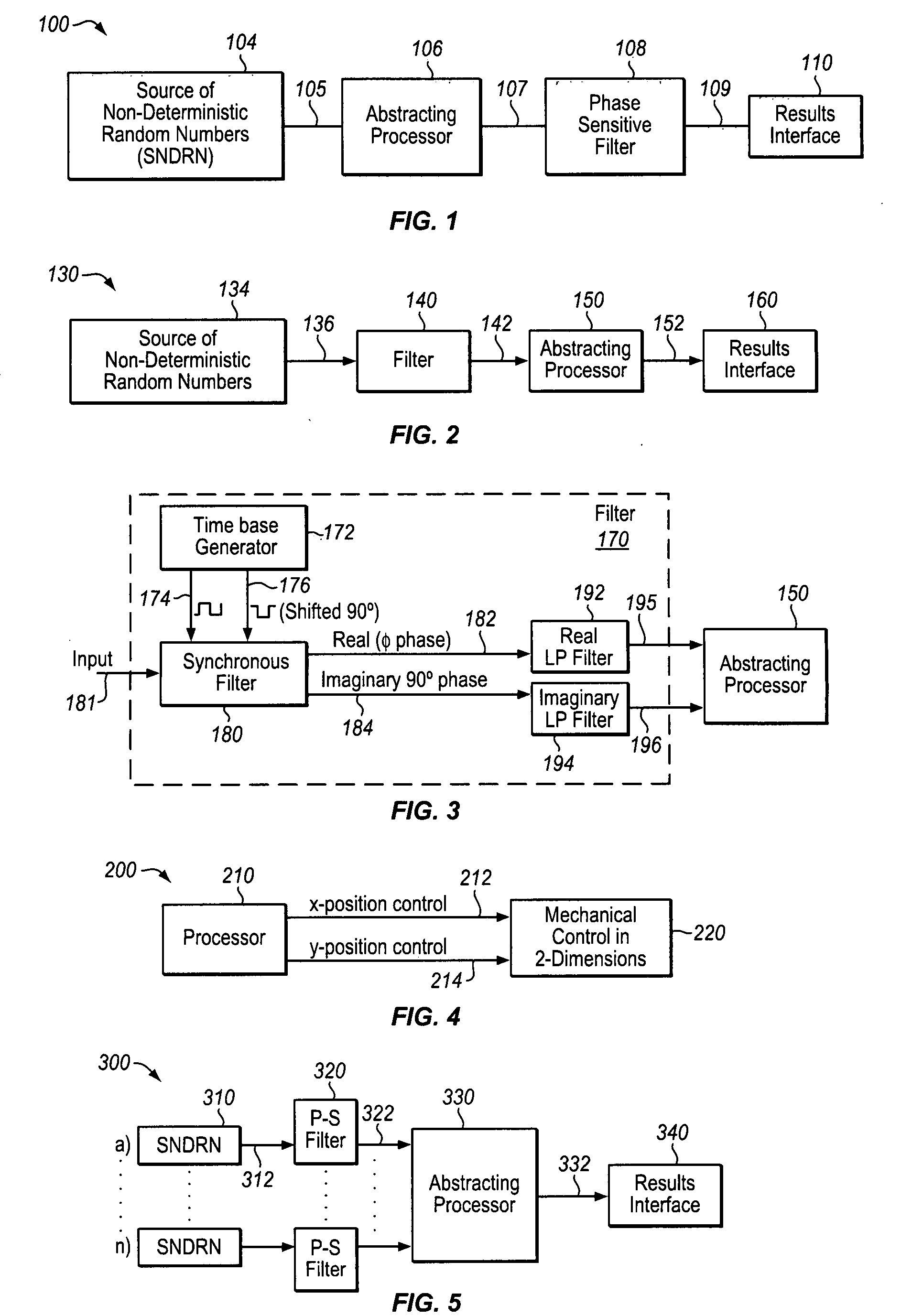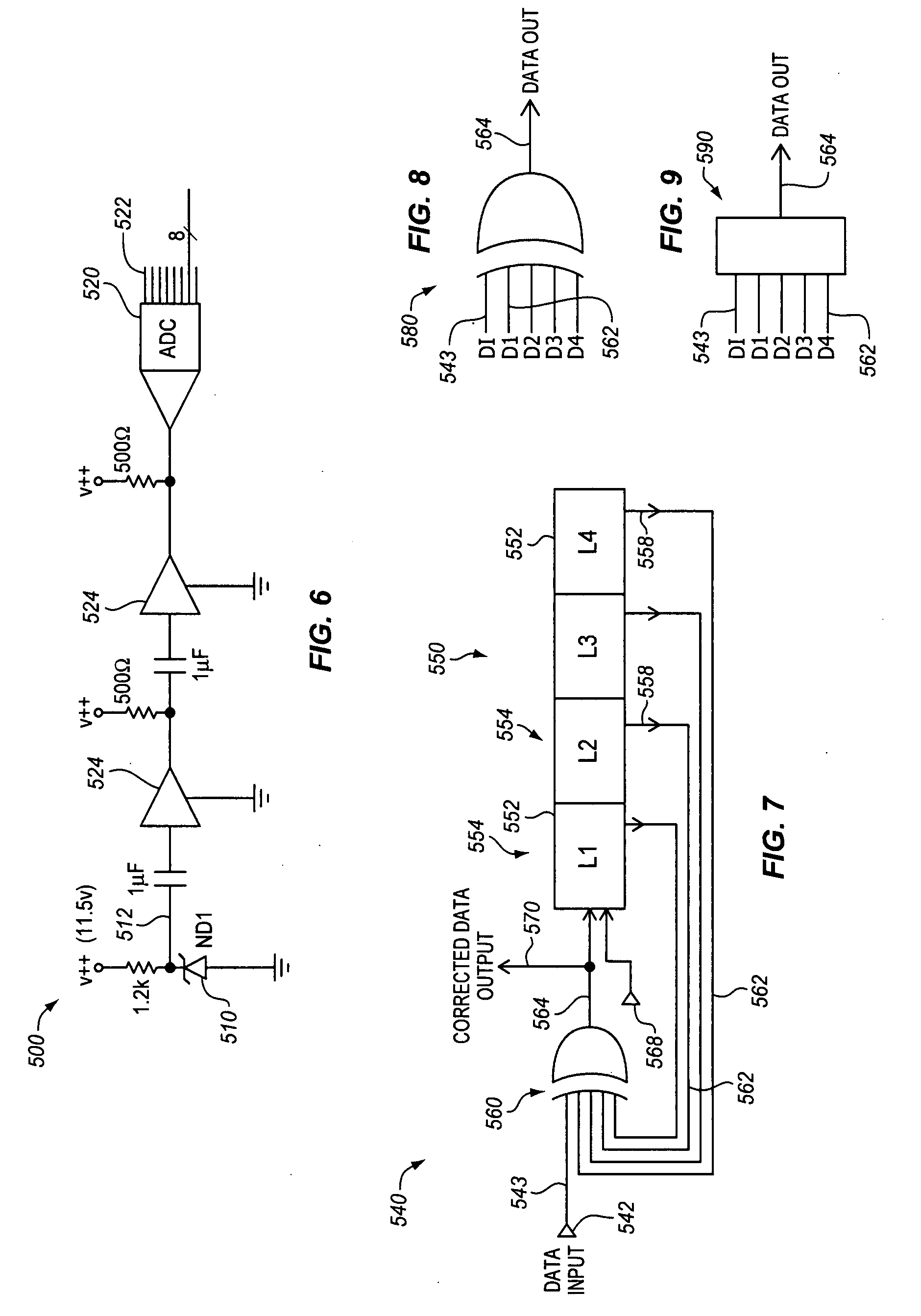Device and method responsive to influences of mind
a technology of mind and device, applied in the field of information detection and transfer, can solve the problems of inability to achieve general practical applications of mmi, complex and expensive apparatuses for experiments involving mmi, and inability to immediately translate laboratory demonstration into useful devices or methods, etc., to achieve high accuracy, improve the performance of mmi technology, and improve the effect of mmi technology
- Summary
- Abstract
- Description
- Claims
- Application Information
AI Technical Summary
Benefits of technology
Problems solved by technology
Method used
Image
Examples
example 1
[0099]An anomalous effect detector in accordance with the invention contained a synchronous filter that included a synchronous multiplier (or synchronous detector) and a low-pass filter. The synchronous filter was set to filter at 5000 Hz frequency. The cut-of frequency of the low-pass filter was set at 10 Hz. Thus, the bandwidth of the synchronous filter was 10 Hz. From a ring oscillator in a computer, 7000 binary bits per second were extracted and input into the filter. The synchronous square-wave multiplier alternately multiplied the input by +1, then by −1, with a cycle of 14 input bits. In other words, after every seven input numbers, the filter multiplier switched between +1 and −1. The output of the low-pass filter was quasi-continuous digital filtered output. Without an influence of mind, the output was expected to vary randomly between “1” and “−1” following a normal Gaussian distribution. A number of measurements in a selected time period above or below “0” indicated an in...
example 2
[0100]In another working example, an input sequence of source numbers from a source of non-deterministic numbers was processed in a complex filter into a real output and an imaginary output. Thus, the complex filter produced two independent (orthogonal) outputs. Without an influence of mind, each output had a standard Gaussian distribution. When the source numbers were influenced by mind, however, the amplitudes of the two outputs deviated from a normal distribution. The complex filter output was used to produce an “X” and “Y” output by mathematically converting the Gaussian numbers to probabilities, which were uniformly distributed [0,1]. This provided a 2-D analog control.
[0101]In some embodiments, an artificial neural network is used to process output beyond the filter output.
[0102]FIG. 6 contains a block diagram illustrating an exemplary embodiment of a multi-stream SNDRN 500 in accordance with the present invention. Multi-stream SNDRN 500 includes noise diode 510, which is a so...
example 3
[0158]FIG. 26 depicts schematically the principal elements and functional processing steps in preferred embodiment of an anomalous effect detector 840 in accordance with the invention that is operable to process and to abstract raw data from SNDRNS (e.g., from SNDRNS contained in ASNs) to recognize a pattern resulting from an influence of mind. Anomalous effect detector 840 represents essentially a particular embodiment of generalized anomalous effect detector 830 described with reference to FIG. 25, above. Accordingly, among other uses, a system and a method in accordance with those of detector 840 are operable in an artificial sensory detector, ASD. The functional operations embodied in detector 840 were programmed into software and performed using a computer. It is understood, however, that in some embodiments, the same or similar functional processing operations performed in detector 840 are performed using other means and structures, such as one or more programmable microproces...
PUM
 Login to View More
Login to View More Abstract
Description
Claims
Application Information
 Login to View More
Login to View More - R&D
- Intellectual Property
- Life Sciences
- Materials
- Tech Scout
- Unparalleled Data Quality
- Higher Quality Content
- 60% Fewer Hallucinations
Browse by: Latest US Patents, China's latest patents, Technical Efficacy Thesaurus, Application Domain, Technology Topic, Popular Technical Reports.
© 2025 PatSnap. All rights reserved.Legal|Privacy policy|Modern Slavery Act Transparency Statement|Sitemap|About US| Contact US: help@patsnap.com



